TRC’s Measurement Trail: Conducting the Audit

In business, there is theory, and then there is, as we all know, the reality. Sometimes the two don’t connect in a desired fashion. Other times, however, when disparate elements work in harmony as projected, you have that glorious glow because a business plan comes together.
The audit day started inauspiciously. I arrived in Port Washington, Wisconsin, Oct. 22, an ill-tempered day of rain and wind, to find out if theory met reality. It was TRC’s biennial audit of Veolia Environmental Services, the company we chose as the “graveyard,” if you will, of all those thermostats that we collect. The goal was simple: Was Veolia meeting the high standards established previously for the safe recycling and disposal of mercury-containing thermostats?
And while the word audit might suggest added stress or concern, for the participants, none of this occurred during my visit. What I found were professionalism, courtesy and clear and forthright explanations of the processes they follow.
We began by touring the customer service offices in the morning, a few blocks from the processing center. The distance between the two is a brief 10 minute walk.
In the afternoon, I had the opportunity to walk through the processing warehouse. There I shadowed Sara, my main contact, whom I speak with almost every day but had met only once on a previous visit, and Alexis, who is responsible for processing TRC’s bins.
Sara and I spoke about protocols and logistics issues. I wanted to see if our arrangement continues to process the units efficiently and whether there were any new wrinkles of which I should be aware. My observations reassured me that Veolia continued to follow the protocols with exemplary precision. I was able to confirm a new approach to processing FedEx returns out of the warehouse that we instituted after my previous visit. I was pleased that the suggestion had made returns slightly more efficient.
I was also able to review Alexis’ careful handling of our units. It was a fascinating process. She removes covers from the containers that arrive, records the manufacturer or original, counts the mercury ampules, documents any material discrepancies, places the thermostat base and mercury in drums for transport to the return facility down the block for processing, then cleans the green bins and prepares for their return shipment to our collection locations. It’s the proverbial laundry list, and I greatly appreciated the attention to detail that she follows.
It’s worthwhile to remind TRC partners and supporters that all of this activity occurs in a special room built for TRC that houses our thermostats collection, within the warehouse. (They reserve the non-TRC portion of the warehouse for the recycling of electronic components.)
After reviewing Alexis’s procedure, I recalled how important a checklist is, especially when dealing with sensitive products or procedures. It’s gratifying to know that you have a checklist in place and that you follow it faithfully. It is the one aspect of an audit, whether it’s handling volatile elements or going through the checklist as an airline pilot, that confirms you are doing things correctly.
On my flight back home, I thought about the audit and acknowledged that there are really two parts to the one we conducted at Veolia. The first is the obvious one. You want to ensure that the logistics and collection processes are working precisely as intended. We accomplished this to my satisfaction.
There is also the human element. Because no one operates in a vacuum, the personal interaction can be important. Reacquainting myself with the facility while catching up with Sara and meeting Alexis for the first time were helpful. If you know your counterparts, it can smooth out any rough spots if a misunderstanding emerges, and it also, I suspect, provides for a more relaxed and comfortable dialog when discussing issues.
The audit process was a success because TRC was able to confirm, through first-hand observation, that our mission of safely recycling mercury-containing thermostats continues.

